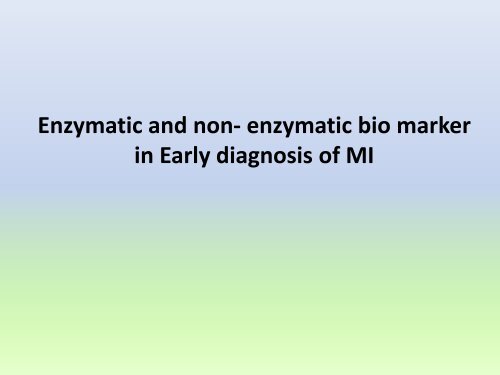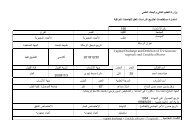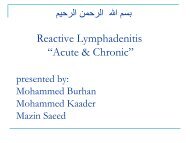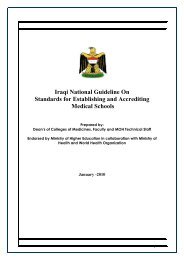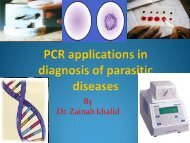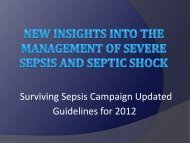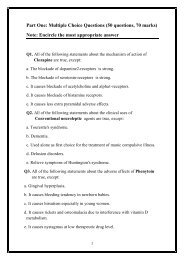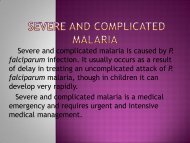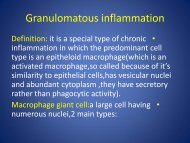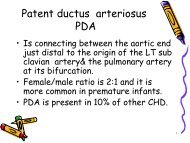Enzymatic and non- enzymatic bio marker in Early diagnosis of MI
Enzymatic and non- enzymatic bio marker in Early diagnosis of MI
Enzymatic and non- enzymatic bio marker in Early diagnosis of MI
Create successful ePaper yourself
Turn your PDF publications into a flip-book with our unique Google optimized e-Paper software.
<strong>Enzymatic</strong> <strong>and</strong> <strong>non</strong>- <strong>enzymatic</strong> <strong>bio</strong> <strong>marker</strong><strong>in</strong> <strong>Early</strong> <strong>diagnosis</strong> <strong>of</strong> <strong>MI</strong>
A cute myocardial <strong>in</strong>farction (A<strong>MI</strong>) is thelead<strong>in</strong>g cause <strong>of</strong> death <strong>in</strong> developedcountries; however, hospital mortalityfrom this cause has been decl<strong>in</strong><strong>in</strong>g overthe last three decades.this reduction <strong>in</strong>mortality co<strong>in</strong>cides with the improvement<strong>in</strong> health <strong>and</strong> liv<strong>in</strong>g st<strong>and</strong>ards <strong>and</strong> withnew treatments like thrombolysis
And new <strong>in</strong>terventions likepercutaneous coronary <strong>in</strong>terventions(PCI) <strong>and</strong> coronary artery bypassgraft<strong>in</strong>g(CABG).
The success <strong>of</strong> treatment rests on:identification <strong>of</strong> patients <strong>in</strong> the veryearly stages <strong>of</strong> A<strong>MI</strong>
The ideal characteristics <strong>of</strong> a <strong>marker</strong><strong>of</strong> myocardial <strong>in</strong>jury are: it should beabundant <strong>in</strong> the myocardium <strong>and</strong> notpresent <strong>in</strong> other tissues. This gives it ahigh specificity for the myocardium<strong>and</strong> reduces the rate <strong>of</strong> false positiveresults.
Cardiac <strong>marker</strong>s play an importantrole <strong>in</strong> the detection <strong>of</strong> A<strong>MI</strong> when thepatients history <strong>and</strong> ECG are <strong>non</strong>diagnostic
Cardiac <strong>bio</strong><strong>marker</strong>s• CK-MB is the heart spesificisoenzyme <strong>and</strong> has been the goldst<strong>and</strong>ard enzyme for the <strong>diagnosis</strong><strong>of</strong> A<strong>MI</strong>.
Myoglob<strong>in</strong>• A prote<strong>in</strong> found <strong>in</strong> striated skeletal <strong>and</strong>cardiac muscles, myoglob<strong>in</strong> is an early <strong>marker</strong><strong>of</strong> <strong>in</strong>jury to muscle tissue. A rise <strong>in</strong> myoglob<strong>in</strong>concentration is detectable <strong>in</strong> blood as earlyas 1 to 3 hours after the onset <strong>of</strong> <strong>MI</strong>symptoms <strong>and</strong> can be used to rule out the<strong>diagnosis</strong> <strong>in</strong> the 2 to 6 hours period after Theonset <strong>of</strong> symptoms.the disadvantage <strong>of</strong>myoglob<strong>in</strong> is that it is not cardiac specific.
It can be <strong>in</strong>creased <strong>in</strong> trauma,diseases <strong>of</strong> theskeletal muscles,<strong>and</strong> renal failure. Myoglob<strong>in</strong>concentrations for adult men range from 30 to90 ng/dL; women typically demonstrateconcentrations <strong>of</strong> less than 50 ng/mL.Myoglob<strong>in</strong> can be measured by latexagglut<strong>in</strong>ation,enzyme-l<strong>in</strong>ked immunosorbentassay(ELISA),immu<strong>non</strong>ephelometry,<strong>and</strong>fluoroimmunoassy.A spot test us<strong>in</strong>gimmunochromatography is also available.
tropon<strong>in</strong>s• Tropon<strong>in</strong>s is a complex <strong>of</strong> three prote<strong>in</strong>sthat b<strong>in</strong>d to the th<strong>in</strong> filaments <strong>of</strong>striated cardiac or skeletal muscle <strong>and</strong>regulated muscle concetraction. Thecomplex consist <strong>of</strong> the follow<strong>in</strong>g :• Tropon<strong>in</strong> T (TnT)• Tropon<strong>in</strong> I (TnI)• Tropon<strong>in</strong> C (TnC)
Tropon<strong>in</strong> I rema<strong>in</strong> <strong>in</strong>vated <strong>in</strong>blood for 4 to 10 days after <strong>MI</strong> <strong>and</strong>thus is valiable for late present<strong>in</strong>gpatients.
Heart-type acid-b<strong>in</strong>d<strong>in</strong>g prote<strong>in</strong> test<strong>in</strong> the prehospital diagnostic test <strong>of</strong>acute myocardial <strong>in</strong>farction.
Copept<strong>in</strong> the release pattern <strong>of</strong>copept<strong>in</strong> <strong>in</strong> patients with A<strong>MI</strong> withimmediate rise after onset <strong>of</strong> chestpa<strong>in</strong> <strong>and</strong> decrease toward physiologiclevels with<strong>in</strong> 5 days.
Myeloperoxidase, but not C-reactiveprote<strong>in</strong>, predicts cardiovascular risk <strong>in</strong>peripheral arterial disease, althoughC-reactive prote<strong>in</strong> is a predictor <strong>of</strong><strong>in</strong>flamatory changes .
Previous Cardiac <strong>marker</strong>s:1- Sgot(Ast).2- LDH.3- Total cpk.


